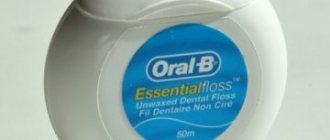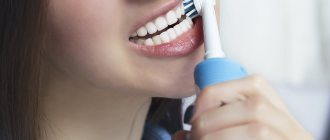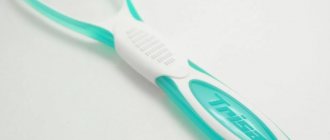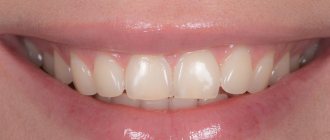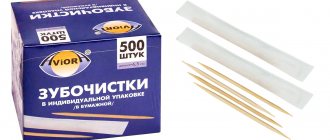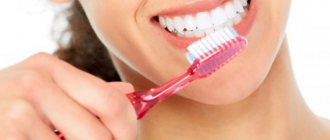The benefits of quality teeth cleaning are talked about a lot and often. After all, dental treatment and prosthetics are not a cheap pleasure, and preserving your own teeth is the main goal of regular visits to dental clinics. But did you know that plaque contains up to 300 different bacteria? What about the fact that traditional brushing only affects 60% of the tooth surface? And that not all plaque can be cleaned with a toothbrush? Ideally, the arsenal of devices for cleaning dental surfaces should consist of a toothbrush, irrigator and dental floss. Today we will talk about dental floss and the features of their use together with a hygienist from the network of dental clinics “All Yours!” Anna Derevyannykh.
What is dental floss used for?
A tooth has five surfaces. According to our expert hygienist Anna Derevyannykh, even the most thorough brushing of teeth with a toothbrush helps clean only those parts of the tooth that are accessible from the outside, that is, three out of five surfaces.
“Dental floss is needed to clean the dental space between the triangle-shaped gingival papilla and the tooth. This space is also called the periodontal sulcus. Also, when brushing, the contact surface of the tooth is affected,” says the expert.
Dental floss helps clean those spaces where a toothbrush cannot reach. An irrigator does not always help to achieve good results when brushing; it cannot cope with hard plaque. Dental floss is especially important for people whose teeth are very crowded, that is, they are located very tightly to each other. If contact caries occurs on such teeth, it may not be immediately noticeable to an unprofessional eye, and as a result, two adjacent teeth will require treatment, which is significantly more expensive than dental floss.
For those who love toothpicks, we have bad news: they are more damaging to tooth enamel and less effective at cleaning plaque from interdental spaces than floss. In addition, toothpicks cause more injury to the gums and ligaments that hold the tooth in the bone.
pixabay.com/
Satin Floss
- Material: nylon;
- Length per skein: 25 meters;
- Feature: waxed, tape;
- Taste : mint.
The basis of the interdental floss Oral-bi Sanit Floss is oval nylon fibers enclosed in a polymer shell. When brushing your teeth, the floss does not slip, it is easy to wrap around your fingers, and it does not break. The product is not prone to delamination and perfectly retains its original shape.
They are produced in the form of a flat tape, due to which there is a more effective and high-quality cleansing of bacterial plaque and food debris even in hard-to-reach places (compared to the usual form of threads), which prevents the occurrence of caries and gum disease.
The special silky waxed structure of Oral-B Satin Floss threads allows you to carry out hygienic procedures without the risk of injury to soft tissues - as it glides easily even between teeth that are tightly spaced together. This product, soft in structure, is recommended for use even by people with highly sensitive gums.
We have prepared for you a review of the Panasonic EW 1211 irrigator. You can read it in a separate article. And here you can read reviews about Rox whitening toothpaste.
The minty scent of Oral-B Satin Floss will leave you with an invigorating feeling of freshness for a long time.
The cost of one package varies around 250-300 rubles.
What does dental floss look like?
Dental floss, like regular floss, is a spool or roll packaged in a plastic container with a lid. There is a cutting edge on the edge of the cap, with which you can cut off the desired length. The threads can also be presented as a disposable flosser, where the thread is stretched between two holders. Such devices are more expensive in cost, but, according to some users, they are more convenient. Modern manufacturers make packages with threads as comfortable as possible in order to carry them with you and use them for cleaning at any time and anywhere.
Application algorithm for braces
After installing orthodontic structures, the doctor informs the patient about the rules for caring for them. To effectively clean devices, you must use brushes, toothbrushes, floss or irrigators. Food particles can easily get caught under hooks, locks and other elements of orthodontic structures, which cause bad breath.
The orthodontist teaches proper oral care using superfloss. This product performs the functions of several types of dental floss. The main point of training is to avoid damaging the structure itself and soft tissues during oral hygiene.
Photo of cleaning braces with floss
Algorithm for the procedure:
- Hands are treated with an antiseptic or washed with soap.
- The cleansing procedure is carried out in front of a mirror to examine all the elements of the orthodontic device.
- About 30 cm of thread is wound around the index fingers of both hands.
- The fiber is hooked under the main wire without touching the metal parts.
- After cleaning the braces, the accessory is hooked into each interdental space. To process closely spaced units, manufacturers make special narrow threads.
- The floss is removed from the mouth at one end to prevent damage to the braces.
- The used fishing line is disposed of.
Without floss, it is impossible to achieve ideal cleanliness of the oral cavity, especially with orthodontic devices installed.
What types of dental floss are there?
The second name for dental floss is floss (also dental floss or dental floss). Dental floss can be divided into two large groups: superflosses and flosses. Superfloss is much wider than simple dental floss and is used to clean orthodontic structures - for example, the spaces between crowns, including implants. Regular flosses come in waxed and unwaxed varieties. The first of them are impregnated with wax, the second do not contain wax impregnation.
In addition, threads are made of silk, but this material is not very durable. In practice, threads made of artificial fibers - nylon, nylon, Teflon - are more often used.
Unwaxed threads are suitable for those who suffer from various types of allergies. In addition, their fibers fluff up a little during use and help to capture more space that needs cleaning.
Floss impregnations are antibacterial and deodorizing. Common examples of antibacterial impregnations are chlorhexidine and various herbal extracts. Flosses with potassium nitrate will help in the fight against caries, and with menthol they will keep your breath fresh.
As we have already mentioned, thread manufacturers take care of convenient, compact packaging, so in almost any pharmacy you can buy a mini thread that can easily fit even into a handbag.
pixabay.com/
Advantages
Oral-B's oral care products have become extremely popular among users, and floss is no exception.
Dental floss of this brand has many advantages that set them apart from similar products. The key advantage of Oral-B flosses is their monostructure. The thread consists of many thin nylon fibers coated with a polymer sheath. They are woven together so tightly that the possibility of splitting and abrasion is absolutely excluded.
The advantages of floss from the Oral Bee brand include the following points:
- the minimal cross-section and elasticity of the product allow it to be used even in cases of very close concentration of teeth;
- the polymer coating prevents the thread from slipping in your hands, which guarantees the absence of unintentional damage;
- special impregnation with which the product is coated provides protection against caries and protects the enamel from damage;
- some Oral Bee floss models swell under the influence of saliva , which ensures high-quality cleaning of the tooth surface near the gums;
- the structural features of dental floss provide the possibility of high-quality cleansing of orthodontic systems;
- The brand's flosses have a mint flavor , providing fresh breath after use;
- The compact case protects the product from contamination , and the built-in knife provides convenient separation of the length required for single use.
The described quality indicators of Oral Bee brand floss are complemented by a low price, which contributes to the growing popularity of the company’s products.
What does the expression “tetracycline teeth” mean and how to get rid of the problem. See here photos of red spots on the tongue and find out how the disease is diagnosed based on their location.
At this address https://dr-zubov.ru/lechenie/bolezni-polosti-rta/stomatit-bpr/kandidoznogo.html read about the treatment of candidal stomatitis in children.
How to use dental floss correctly?
To use dental floss, you need to tear off a fairly large piece of it from the spool and pull it between the index fingers of your left and right hands, and then fix it and carefully insert it into the space between the teeth with small sawing movements to facilitate insertion. The floss should be inserted into the interdental space until it stops, while avoiding pain. The thread is drawn out along the wall of the tooth. In one tooth gap, this manipulation must be done twice, pulling the thread first along one tooth and then along the adjacent one. This way we clean the spaces between all the teeth in the mouth. A measured piece of thread can only be used once to avoid infections.
Pro-Expert
- Material: nylon.
- Length per skein: 25 meters.
- Feature: waxed, tape, thin.
- Taste: mint.
The professional product Oral-bi Pro Expert does an excellent job of cleaning the interdental space and the line around the gums. The durable mono-structural thread has a ribbon shape and does not delaminate or break during the cleaning procedure.
In addition, it is very convenient to use - due to the polymer coating, it can be easily wrapped around your fingers and does not slip.
The floss is quite thin and can be recommended even for people with crowded teeth, as it provides easy glide, penetration into the most difficult areas and effective removal of plaque and food particles.
Special protective technology and the soft structure of the floss protect the soft tissues of the oral cavity from the risk of traumatic effects.
The product has a pleasant invigorating taste and mint aroma, giving a long-lasting feeling of freshness.
The cost of one package varies around 170-200 rubles.
Is there a danger of harming teeth and gums when using dental floss?
“There is no great danger to the integrity of the tooth and gums when using dental floss,” says FAN expert Anna Derevyannykh. “But still, it doesn’t hurt to be careful when using floss.”
Too intensive use can lead to injury to the gum epithelium. This should be especially taken into account by people suffering from periodontal disease, since intensive cleaning of teeth with floss can increase bleeding.
Teeth with caries also need careful surface treatment, since the enamel is weakened and chips may form. A more gentle treatment with threads is also needed for any other inflammation of the gums.
For those who have recently had dental crowns and bridges placed, the use of floss to clean dental cavities should definitely be discussed with your dentist. There is a general consensus that using flossers in such cases is not recommended.
Children can use floss starting from about 8–10 years old, but at first they must be supervised by adults.
Recommendations
It is recommended for everyone to use thread. But in order to achieve maximum results from its use, you need to know the features of its use:
- The procedure should be carried out before brushing and toothpaste.
- It is recommended to use after each snack, but if this is not possible, then at least 2 times a day.
- In order not to injure the mucous and soft tissues of the gums, all movements should be performed smoothly, carefully, without pressure.
- It should not reach the gums.
- A piece used on one tooth should not be reused on another.
- When performing the procedure, you should pay attention to the gums. If bruising is detected, stop brushing and rinse your mouth with water.
All about hypertrophic gingivitis and treatment in clinics and at home. This article contains details about the purpose and use of Lincomycin in dentistry.
Follow the link https://dr-zubov.ru/lechenie/bolezni-polosti-rta/effektivnye-sredstva-i-recepty-yazvy.html to learn more about treating mouth ulcers at home.
Flossstick and flosset
In the classic version, floss goes on sale in the form of a compact closed spool on which the thread is wound. But besides this option, you can also find similar products on the shelves, but with different names: flosset or flossstick.
Pharmacists often offer them as a substitute for dental floss, but the devices have a completely different shape.
Flosset
A flosser is a device used to clean the teeth using floss. It makes it possible to cleanse without twisting the fiber around your fingers .
The device includes several elements that represent a single system: a handle-container and a two-fork thread tensioner. A spool of floss is installed inside the container handle or its end.
Through a special hole, the fiber is fed to the ends of the tensioner forks and is fixed there.
All the user has to do is clean it and then pull out the used piece of wire and tear it off. This way the tensioner will again have a clean piece of thread.
Thanks to their ease of use, flossets are becoming increasingly popular. Currently, there are flossets with a semicircular (wide) and fork-shaped (narrow) tensioner. The narrow model is recommended for use for oral hygiene in childhood.
Compared to regular dental floss, flossing has both advantages and disadvantages. The advantages of this device include:
- Possibility of use for people of any age ;
- Ease of use;
- the device copes well with removing plaque in cases of abnormal structure of the jaw apparatus or its injury;
- the device will be indispensable for people with pathology of the finger joints ;
- a more hygienic tool than a regular thread, as it precisely delimits the areas of the fiber used.
The device also has some disadvantages:
- high cost of the device;
- limited fiber length and inability to change the reel. If the thread runs out, you will have to buy a new device;
- difficulty cleaning molars;
- high risk of thread getting stuck or breaking in the presence of dentures or low-quality fillings. At the same time, it is very difficult to install the thread in the tensioner forks;
- Compared to the classic version of the thread, the device is quite voluminous . Therefore, most often it is used only at home.
Flossstick
Flossstick is a disposable device that combines the functions of dental floss and toothpick. Externally, flossstick differs from flosset. The only similar element is the thread tensioner, which is mounted on a thin flat handle.
The end of the handle has a point and acts as a toothpick. The device is ready for use and can only be used once . After the cleansing procedure, it is impossible to replace the fiber.
To manufacture the device, highly flexible plastic is used, which allows it to reach all areas of the oral cavity.
Most often, the product goes on sale in sets of 4–8 pieces. As a rule, up to 5 pieces are enough for a day. Just like regular dental floss, floss stick can be purchased with fiber treated with some kind of impregnation.
Advantages of flossstick over conventional dental floss:
- simplicity and ease of use;
- efficiency;
- high fiber twist allows for better cleaning;
- variety of assortment.
The disadvantages of this device include:
- excessive fiber tension often leads to injury to the gum tissue ;
- all devices use fiber of the same size and shape , which makes it difficult to use in case of non-standard dentition;
- high probability of rupture in the presence of fillings and prostheses.
Look at the photo on how to properly brush your teeth with a brush, brush and floss.
This article tells you which electric toothbrush is suitable for a 7-year-old child.
Here https://zubovv.ru/krasota-i-uxod/otbelivanie/domashnee/maslo-chaynogo-dereva.html you will find out whether tea tree oil is harmful for teeth whitening?
Flossing for Children
Children no earlier than 9 years old can use the accessory independently. However, you can introduce your child to the product much earlier.
It is important to teach your child good oral hygiene from an early age.
It is better for younger children to use the thread under parental supervision. It is important to ensure that the child carefully performs all manipulations and does not damage the gums and mucous membranes of the mouth. If during the process of cleaning the interdental spaces the baby’s gums begin to bleed, then the procedure is postponed and the mouth is washed with a warm antiseptic solution. You can resume flossing only after the bleeding has disappeared.
Reviews
Regardless of the type, dental floss has always received only positive reviews. Users noted that when using it, it is not so much the shape and material of the fiber that plays a role, but rather the consistency. We invite readers to share their feedback about flossing in the comments to this article.
If you find an error, please select a piece of text and press Ctrl+Enter.
Tags dental floss dental care oral care floss flosset flossstick
Did you like the article? stay tuned
